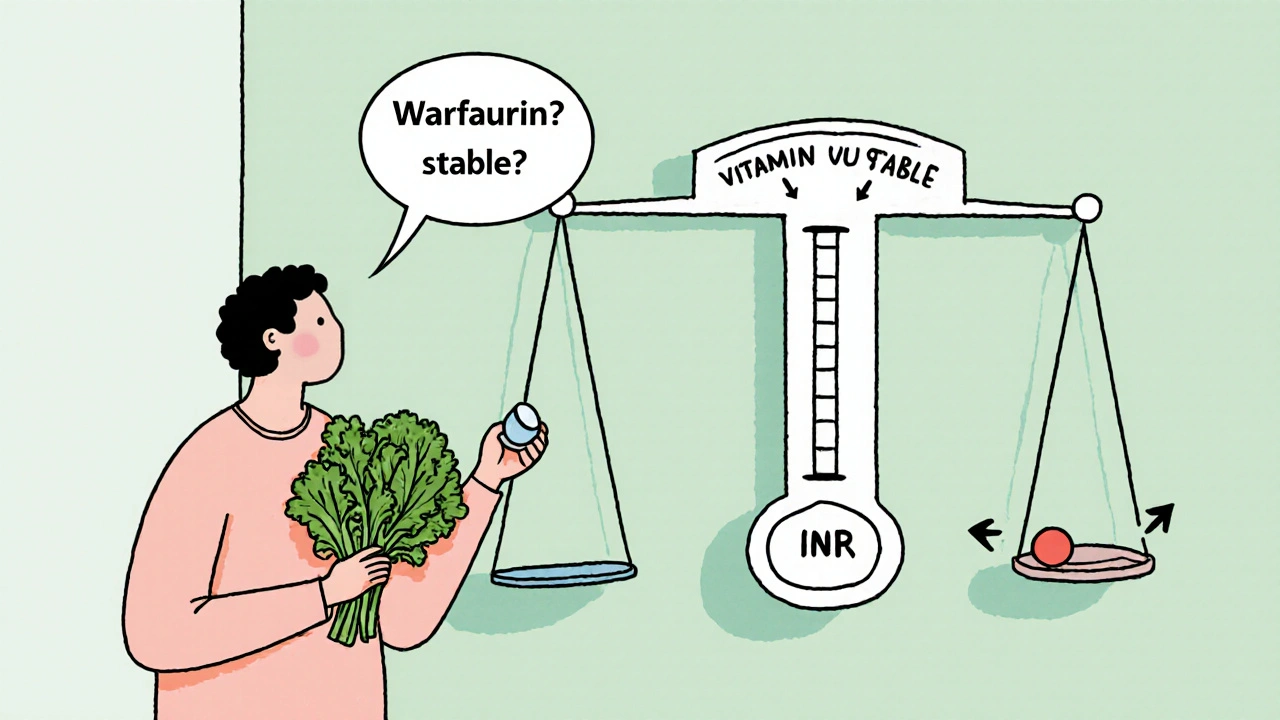Vitamin K Intake Calculator
Vitamin K Intake Tracker
Calculate your daily vitamin K intake based on your meals to maintain consistent levels for warfarin therapy.
Recommended range: 60-120 µg
When you’re on warfarin, the biggest headache is watching the INR swing like a pendulum. The culprit isn’t always a missed dose - it’s often the daily amount of vitamin K you eat. This guide shows why keeping vitamin K intake steady matters, how the body’s chemistry links the two, and practical steps you can take to lock your INR in the therapeutic sweet spot.
What warfarin does - and why vitamin K matters
Warfarin is a synthetic anticoagulant that blocks the enzyme vitamin K epoxide reductase complex subunit 1 (VKORC1). By stopping VKORC1, warfarin prevents the recycling of vitamin K back to its active hydroquinone form, which is essential for the gamma‑carboxylation of clotting factors II, VII, IX, and X. Without that modification the clotting factors stay inactive, and blood takes longer to clot.
Enter vitamin K. Found as phylloquinone (K1) in leafy greens and menaquinones (K2) in animal foods, it directly feeds the same clotting‑factor pathway warfarin tries to shut down. More vitamin K means the body can “out‑run” warfarin’s effect, dropping the INR; less vitamin K lets warfarin dominate, pushing the INR up.
INR 101 - the numbers that matter
The International Normalized Ratio (INR) standardises how we measure clotting time. Most patients aim for a range of 2.0-3.0; those with mechanical mitral‑valve prostheses target 2.5-3.5. The higher the INR, the longer it takes blood to clot, and the higher the bleed risk. The lower the INR, the greater the chance of a clot forming.
Time in Therapeutic Range (TTR) is the gold‑standard quality metric - it tells you the percentage of days your INR stayed inside that target window. Every 10% rise in TTR translates to roughly a 15% cut in major bleeding or thrombotic events.
Why diet consistency beats restriction
Older textbooks told patients to avoid green veggies altogether. Modern guidelines from the ACCP, AHA, and Anticoagulation Forum say the opposite: keep vitamin K intake predictable, don’t cut it out.
- A 2019 Thrombosis & Haemostasis study found patients with erratic vitamin K consumption experienced 2.3 × more INR excursions outside the target range.
- University of Iowa researchers showed that staying within ±20% of your usual vitamin K level boosted TTR by 14.7 percentage points.
- A 2015 Blood trial demonstrated that adding a modest 150 µg of vitamin K daily raised TTR from 58.4% to 65.6% without extra bleeding events.
In short, consistency gives your warfarin dose a stable opponent, letting the INR settle where it belongs.
How to make vitamin K intake consistent
Think of vitamin K like a daily budget. You choose a number (usually 60‑120 µg per day) and then stick to it, spreading the intake across meals.
- Pick a target range. Most clinics recommend 90 µg for women and 120 µg for men, but 60‑120 µg works for most patients.
- Measure, don’t eyeball. Use a kitchen measuring cup or a digital food scale. Visual guesses of a handful of kale can swing the vitamin K dose by up to 45%.
- Plan a weekly menu. Write down which vitamin‑K‑rich foods you’ll eat each day. For example, one cup of cooked spinach (≈ 889 µg) is a “big day” offset by a day of low‑K foods like chicken breast (≈ 2 µg).
- Track for the first 4‑6 weeks. Keep a simple diary - note food, portion size, and calculated µg. After the stabilization period, you can loosen up a bit while staying within ±20% of your average.
Below is a sample weekly template that averages 100 µg per day:
- Monday: Breakfast - scrambled egg (20 µg); Lunch - ½ cup cooked broccoli (102 µg); Dinner - grilled salmon (5 µg).
- Tuesday: Breakfast - oatmeal (no K); Lunch - turkey sandwich (5 µg); Dinner - 1 cup raw kale (547 µg) plus a small side salad (30 µg).
- …continue alternating high‑K and low‑K days to keep the weekly average steady.
Tools that make consistency easy
Technology has turned a tedious diary into a click‑away task.
| Approach | Typical Vitamin K Intake | Effect on TTR | Pros | Cons |
|---|---|---|---|---|
| Strict Restriction | < 50 µg/day | -5‑10 pts | Simple to explain | Higher INR swings, possible deficiency |
| Consistent Intake (±20%) | 60‑120 µg/day | +10‑15 pts | Better INR stability, maintains nutrition | Requires tracking |
| Supplementation (150 µg/day) | Variable + 150 µg | +7 pts (studied) | Can be added on unstable days | May be unnecessary for many |
Apps such as Warframate provide a built‑in vitamin‑K database covering 1,200+ foods and let you log portions with a tap. The University of North Carolina’s “Vitamin K Consistency Calculator” spits out a personalized weekly plan based on your target µg level.
Personalizing the plan - genetics and labs
Not everyone reacts the same way to the same amount of vitamin K. Variants in the VKORC1 and CYP2C9 genes can make you 30‑50% more sensitive to dietary swings. A 2023 pharmacogenomics study suggested tighter consistency (±10%) for VKORC1 variant carriers, while wild‑type patients can tolerate a broader ±25% window.
If you have access to genetic testing, bring the results to your anticoagulation clinic. The clinic can then set a “personal vitamin‑K bandwidth” that matches your genotype and your current warfarin dose.

Common pitfalls and how to avoid them
- Thinking all greens are equal. Spinach, kale, and collard greens differ wildly in µg per cup. Use a reliable database instead of guessing.
- Changing the diet abruptly. If you switch from a low‑K to a high‑K week, do it gradually over 3‑5 days while checking INR more often.
- Relying on visual portion size. A “handful” can be 30 g or 100 g. Weigh it the first few times.
- Missing the weekly average. A single high‑K meal is okay if the rest of the week balances out.
- Skipping pharmacist counseling. Certified anticoagulation pharmacists can fine‑tune your dose within days of a diet change.
Quick‑start checklist for patients
- Ask your clinician for a target vitamin‑K range (usually 60‑120 µg/day).
- Buy a measuring cup or kitchen scale.
- Log every vitamin‑K‑rich food for the next 4 weeks using a paper diary or an app.
- Review the log with your pharmacist; adjust warfarin dose if your average deviates >20%.
- Re‑measure INR twice a week during the first month of any diet change.
- After stability, keep a simple weekly menu and revisit only if you travel or start a new supplement.
Frequently Asked Questions
Can I eat my favorite leafy greens while on warfarin?
Yes - just keep the amount steady. One cup of cooked spinach (≈ 889 µg) every other day or a half‑cup daily will stay within most 60‑120 µg targets.
What happens if I miss a day of my vitamin‑K intake?
Missing a single low‑K day usually causes only a modest INR rise. Check your INR a few days later; if it stays in range, no dose change is needed.
Should I take a vitamin‑K supplement?
Supplementation helps only if your INR is unstable despite a consistent diet. A 150 µg daily tablet can raise TTR by about 7 pts, but most patients do fine with food alone.
How often should I get my INR checked after changing my diet?
Twice weekly for the first two weeks, then weekly until you see a stable pattern (usually 4‑6 weeks). Your clinic may adjust the schedule based on your baseline stability.
Do genetics really matter for vitamin‑K management?
Yes. VKORC1 and CYP2C9 variants can make you 30‑50% more sensitive to dietary swings, meaning you might need a tighter ±10% consistency window.
Staying on warfarin doesn’t have to feel like a roller‑coaster. By treating vitamin K like a steady paycheck rather than a surprise windfall, you give your INR a calm environment, cut hospital visits, and keep your life moving forward.

8 Comments
Rachel Zack
October 26 2025
If you cant be consistent with your meals you’re basically asking for trouble.
Nic Floyd
October 28 2025
Yo the key is to treat vitamin‑K like any other pharma‑nutrient metric 📊 keep the daily µg intake within a tight bandwidth and use a digital scale for portion control it eliminates the guesswork and stabilizes your INR 🤖 apps like Warframate have built‑in databases you can log with a tap and get instant feedback 🚀
Johnae Council
October 29 2025
Okay, let me break this down for the clueless crowd. First off, you can’t just eat a kale smoothie one day and a steak the next and expect the same INR. That’s basic chemistry – vitamin K fuels clotting, warfarin blocks it, and the balance is like a seesaw. If you tip the seesaw with a massive leafy‑green binge, the warfarin gets outpaced and your INR drops. Flip the script and go low‑K for a few days, and the INR shoots up, putting you at bleed risk. The studies cited aren’t just academic fluff; they show a 2.3× increase in excursions when people play dietary roulette. Consistency isn’t a buzzword, it’s a therapeutic strategy that keeps your numbers in the sweet spot. Think of your diet as a budget – you wouldn’t spend $10,000 on groceries one week and $100 the next, right? Same principle applies. Track your intake, aim for ±20% of a set target, and let your pharmacist fine‑tune the dose. Genetics can make you more sensitive, but even without testing, a steady plan helps. Don’t be a hero and ignore the data – your INR is not a guessing game. Stick to a plan, use a scale, review the log with a professional, and you’ll avoid the roller‑coaster. The bottom line: erratic eating equals erratic INR, and that equals trouble. Keep it consistent, keep it safe, keep it simple.
Erin Leach
October 31 2025
I totally get how overwhelming all this can feel. It helps to start simple – pick a handful of favorite veggies and measure them for a week. Then share what you’ve logged with your pharmacist, they’ll appreciate the effort and can tweak your dose if needed.
Tim Waghorn
November 2 2025
Regarding your tracking methodology, it is advisable to employ a calibrated digital scale to ensure gram‑level accuracy. Additionally, document both the type of vegetable and its cooked versus raw state, as the vitamin‑K content differs substantially. Submit the compiled data to your anticoagulation clinic for precise dose adjustments.
Brady Johnson
November 3 2025
Seriously, if you think a few extra micrograms of K are harmless, think again – you’re flirting with a bleed risk that could land you in the ER. Your diet choices have consequences, and playing fast‑and‑loose is just reckless. Stick to the plan or suffer the fallout.
Jay Campbell
November 5 2025
Let’s keep the focus on practical steps and support each other’s progress.
Laura Hibbard
November 7 2025
Wow, you all sound like you’ve mastered the art of turning a simple diet into a full‑blown science project – impressive, but maybe just enjoy a balanced plate and let the medics do their thing? 🙄